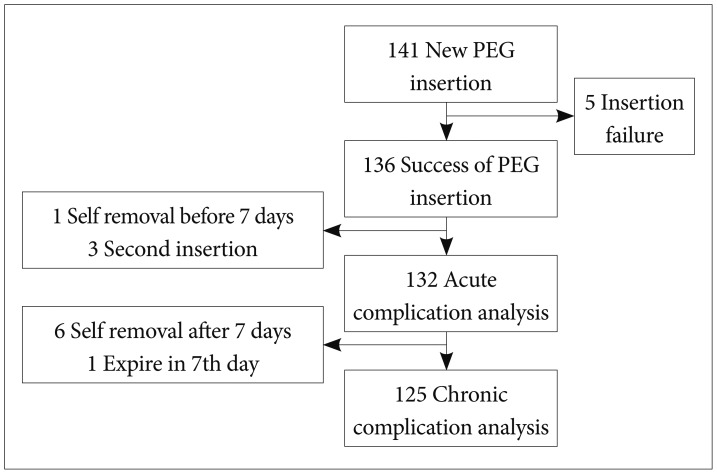Clin Endosc.
2014 Nov;47(6):530-537. 10.5946/ce.2014.47.6.530.
Comparison of Clinical Outcomes Associated with Pull-Type and Introducer-Type Percutaneous Endoscopic Gastrostomies
- Affiliations
-
- 1Department of Internal Medicine, Asan Medical Center, University of Ulsan College of Medicine, Seoul, Korea. jhlee.gi@amc.seoul.kr
- KMID: 2134491
- DOI: http://doi.org/10.5946/ce.2014.47.6.530
Abstract
- BACKGROUND/AIMS
Percutaneous endoscopic gastrostomy (PEG) is a method of providing enteral nutrition using endoscopy. The PEG techniques differ according to the insertion method, and include the pull type, push type, and introducer type. The aim of this study was to compare the clinical outcomes associated with the pull-type and introducer-type PEG insertion techniques, which included the adverse events, at our tertiary care center in Korea.
METHODS
We retrospectively reviewed 141 cases that had undergone PEG insertion at our center from January 2009 to June 2012. The indications for PEG insertion and the acute and chronic complications caused by each type of PEG insertion were analyzed.
RESULTS
The indications for PEG insertion in our cohort included neurologic disease (58.7%), malignancy (21.7%), and other indications (19.6%). Successful PEG insertions were performed on 136 cases (96.5%), and there were no PEG-associated deaths. Bleeding was the most frequent acute complication (12.8%), and wound problems were the most frequent chronic complications (8.8%). There were no statistically significant differences between the pull-type and introducer-type PEG insertion techniques in relation to complication rates in our study population.
CONCLUSIONS
PEG insertion is considered a safe procedure. The pull-type and introducer-type PEG insertion techniques produce comparable outcomes, and physicians may choose either of these approaches according to the circumstances.
Keyword
MeSH Terms
Figure
Cited by 1 articles
-
Nationwide Survey for Pediatric Gastrostomy Tube Placement in Korea
Sangwoo Lee, Byung-Ho Choe, Ben Kang, Soon Chul Kim
J Korean Med Sci. 2022;37(40):e291. doi: 10.3346/jkms.2022.37.e291.
Reference
-
1. Kirby DF, Delegge MH, Fleming CR. American Gastroenterological Association technical review on tube feeding for enteral nutrition. Gastroenterology. 1995; 108:1282–1301. PMID: 7698596.
Article2. Larson DE, Burton DD, Schroeder KW, DiMagno EP. Percutaneous endoscopic gastrostomy. Indications, success, complications, and mortality in 314 consecutive patients. Gastroenterology. 1987; 93:48–52. PMID: 3108063.3. ASPEN Board of Directors and the Clinical Guidelines Task Force. Guidelines for the use of parenteral and enteral nutrition in adult and pediatric patients. JPEN J Parenter Enteral Nutr. 2002; 26(1 Suppl):1SA–138SA. PMID: 11841046.4. Loser C, Aschl G, Hébuterne X, et al. ESPEN guidelines on artificial enteral nutrition: percutaneous endoscopic gastrostomy (PEG). Clin Nutr. 2005; 24:848–861. PMID: 16261664.5. Gauderer MW, Ponsky JL, Izant RJ Jr. Gastrostomy without laparotomy: a percutaneous endoscopic technique. J Pediatr Surg. 1980; 15:872–875. PMID: 6780678.
Article6. Odelowo OO, Dasaree L, Hamilton Y, et al. Is repeat endoscopy necessary after percutaneous endoscopic gastrostomy. J Assoc Acad Minor Phys. 2002; 13:57–58. PMID: 12362569.7. Russell TR, Brotman M, Norris F. Percutaneous gastrostomy. A new simplified and cost-effective technique. Am J Surg. 1984; 148:132–137. PMID: 6430111.8. Lang A, Bardan E, Chowers Y, et al. Risk factors for mortality in patients undergoing percutaneous endoscopic gastrostomy. Endoscopy. 2004; 36:522–526. PMID: 15202049.
Article9. Nair S, Hertan H, Pitchumoni CS. Hypoalbuminemia is a poor predictor of survival after percutaneous endoscopic gastrostomy in elderly patients with dementia. Am J Gastroenterol. 2000; 95:133–136. PMID: 10638571.
Article10. Blomberg J, Lagergren P, Martin L, Mattsson F, Lagergren J. Albumin and C-reactive protein levels predict short-term mortality after percutaneous endoscopic gastrostomy in a prospective cohort study. Gastrointest Endosc. 2011; 73:29–36. PMID: 21074760.
Article11. Ermis F, Ozel M, Oncu K, et al. Indications, complications and long-term follow-up of patients undergoing percutaneous endoscopic gastrostomy: a retrospective study. Wien Klin Wochenschr. 2012; 124:148–153. PMID: 22382552.
Article12. Cappell MS, Abdullah M. Management of gastrointestinal bleeding induced by gastrointestinal endoscopy. Gastroenterol Clin North Am. 2000; 29:125–167. PMID: 10752020.
Article13. Schapiro GD, Edmundowicz SA. Complications of percutaneous endoscopic gastrostomy. Gastrointest Endosc Clin N Am. 1996; 6:409–422. PMID: 8673334.
Article14. Luman W, Kwek KR, Loi KL, Chiam MA, Cheung WK, Ng HS. Percutaneous endoscopic gastrostomy: indications and outcome of our experience at the Singapore General Hospital. Singapore Med J. 2001; 42:460–465. PMID: 11874149.15. Richter JA, Patrie JT, Richter RP, et al. Bleeding after percutaneous endoscopic gastrostomy is linked to serotonin reuptake inhibitors, not aspirin or clopidogrel. Gastrointest Endosc. 2011; 74:22–34. PMID: 21704806.
Article16. Richter-Schrag HJ, Richter S, Ruthmann O, Olschewski M, Hopt UT, Fischer A. Risk factors and complications following percutaneous endoscopic gastrostomy: a case series of 1041 patients. Can J Gastroenterol. 2011; 25:201–206. PMID: 21523261.
Article17. Faias S, Cravo M, Claro I, Lage P, Nobre-Leitão C. High rate of percutaneous endoscopic gastrostomy site infections due to oropharyngeal colonization. Dig Dis Sci. 2006; 51:2384–2388. PMID: 17078008.
Article18. Sangster W, Cuddington GD, Bachulis BL. Percutaneous endoscopic gastrostomy. Am J Surg. 1988; 155:677–679. PMID: 3369623.
Article19. Gossner L, Keymling J, Hahn EG, Ell C. Antibiotic prophylaxis in percutaneous endoscopic gastrostomy (PEG): a prospective randomized clinical trial. Endoscopy. 1999; 31:119–124. PMID: 10223359.
Article20. Mathus-Vliegen LM, Koning H. Percutaneous endoscopic gastrostomy and gastrojejunostomy: a critical reappraisal of patient selection, tube function and the feasibility of nutritional support during extended follow-up. Gastrointest Endosc. 1999; 50:746–754. PMID: 10570331.
Article21. McClave SA, Chang WK. Complications of enteral access. Gastrointest Endosc. 2003; 58:739–751. PMID: 14595312.
Article22. Zopf Y, Konturek P, Nuernberger A, et al. Local infection after placement of percutaneous endoscopic gastrostomy tubes: a prospective study evaluating risk factors. Can J Gastroenterol. 2008; 22:987–991. PMID: 19096738.
Article23. Van Dyck E, Macken EJ, Roth B, Pelckmans PA, Moreels TG. Safety of pull-type and introducer percutaneous endoscopic gastrostomy tubes in oncology patients: a retrospective analysis. BMC Gastroenterol. 2011; 11:23. PMID: 21410958.
Article
- Full Text Links
- Actions
-
Cited
- CITED
-
- Close
- Share
- Similar articles
-
- Short-Term Complications of Percutaneous Endoscopic Gastrostomy according to the Type of Technique
- Dural Puncture by Introducer when Performing Spinal Anesthesia -A case report-
- Percutaneous Endoscopic Discectomy for Lumbar Disc Herniation
- Percutaneous Radiologic Gastrostomy: A 12-Year Series
- Comparison of Clinical Performance and Safety between Domestic New Pull-type Triple-lumen Sphincterotome and Conventional Sphincterotome: A Prospective Multicenter Trial


